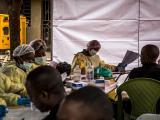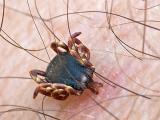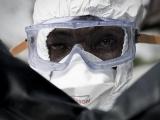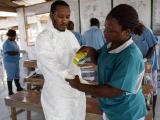Security problems have eased a bit into an "unpredictable calm," as the outbreak continues to intensify, the World Health Organization (WHO) said today, as Democratic Republic of the Congo (DRC) health officials reported 21 more cases.
In other developments today, the International Federation of Red Cross and Red Crescent Societies (IFRC)—a group that plays a key role in safe and dignified burials—said urgent help is needed from the international community before the outbreak escalates further.
And a study on the blood of Ebola survivors detailed how antibodies continue to evolve, months after hospitalization, findings that could help fine-tune vaccines and treatments.
New cases lift outbreak total 1,760
The 21 newly confirmed cases reported today are in eight locations, including 7 in Mabalako, 4 in Katwa, 3 in Musienene, 2 in Beni, 2 in Butembo, and 1 each in Mandima, Vuhovi, and Kalunguta.
The illnesses push the overall outbreak total to 1,760, as health officials investigate 310 suspected cases.
Fourteen more people died from Ebola, seven in community settings and seven in Ebola treatment centers. The fatality count now stands at 1,161.
Concerns about community deaths
In its weekly update today, the WHO said it's especially concerned about community deaths, which make up about 40% of new cases each week. Of 1,147 total deaths reported in the outbreak so far, 68% occurred outside of Ebola treatment centers, meaning patients died at a time when they are most infectious in homes or in health facilities not adequately equipped to isolate and treat patients sickened by the virus.
Such deaths directly result from the main drivers of continued cases, the WHO said, including insecurity that hampers access to critical hot spots, persistent pockets of community resistance, hesitation to participate in response activities, and delayed detection and late presentation of Ebola patients to Ebola treatment centers.
The WHO said transmission is most intense in seven main hot spots: Katwa, Mabalako, Mandima, Butembo, Musienene, Kalunguta, and Beni, which taken together account for 93% of the 350 cases reported over the past 21 days.
The new case reported in Alimbongo this week is linked to Ebola transmission in Katwa, according to the WHO.
In one glimmer of hope amid a bleak situation, the WHO said risk communicators working hard to spread messages about how important it is to seek early care to boost the chance of surviving Ebola are making an impact in Beni. Infected people in that area have been coming to Ebola treatment centers more often and more quickly after symptom onset.
Cases in hot spots will likely continue in the coming weeks, as most response activities resume after a string of security setbacks, the WHO said. The agency warned that increased transmission rates raise the risk of Ebola spreading to other parts of the DRC and to surrounding countries.
Red Cross warns of insecurity, underfunding
In a statement today, Emanuele Capobianco, MD, MPH, the IFRC's director of health and care, said the Ebola response faces a "double jeopardy" of insecurity and critical underfunding. He said the security situation is complex and will require a range of responses including increased community engagement, "However, the funding situation could be fixed. We need more investment now."
Capobianco said the world can't afford for Ebola to become entrenched in the outbreak provinces of North Kivu and Ituri, and the virus can't be allowed to spread to urban areas where it will be harder to contain or to cross international borders.
He said IFRC's work with safe and dignified burials is painstaking but successful. And in areas where Red Cross community engagement volunteers have been able to work, requests for safe burials have increased sharply, with more than 5,000 requested since the outbreak began and a success rate averaging 80%.
Survivor study details antibody evolution
The detailed study of antibodies produced by Ebola survivors was based on blood samples of four Ebola responders who got sick while working in West Africa's outbreak and were treated at Emory University Hospital in 2014. A team from Emory, Stanford University, the University of Wisconsin, the Centers for Disease Control and Prevention (CDC), and the US Army published its findings today in an early online edition of Cell.
The scientists found that high levels of neutralizing antibodies—thought to play a key role in protection—didn't appear in patients' blood until months after they left the hospital. The antibodies they identified might help establish a benchmark of immune protection after vaccination and guide the design of therapies and vaccines.
Duration of protection from the vaccine and how to gauge protection have been unclear, with some studies suggesting that neutralizing antibodies decline several months after vaccination.
Carl Davis, PhD, postdoctoral fellow at Emory Vaccine Center and the study's first author, said in an Emory press release that what researchers saw after tracking how antibodies evolved in the survivors is different than after vaccination. "We did not previously appreciate how long it takes to get to an optimal antibody response after infection," he added.
When the four patients were acutely sick, they produced abundant antibodies that bound to Ebola virus proteins, but high neutralizing antibody production didn't kick in for several months. The researchers said that, over time, antibodies changed the parts of the virus they targeted and how tightly they bound to them. Regions of the antibodies that recruited other immune components also continued to evolve.
Of the four Ebola patients treated at Emory, two got very sick and a third was even sicker, requiring renal replacement therapy and respiratory support.
Davis said, "What was unexpected is that we saw a lot of similarity between the four people, in terms of their antibody responses."
See also:
May 16 WHO Ebola update
May 16 DRC update
May 16 IFRC press release
May 16 Cell abstract
May 16 Emory press release


















